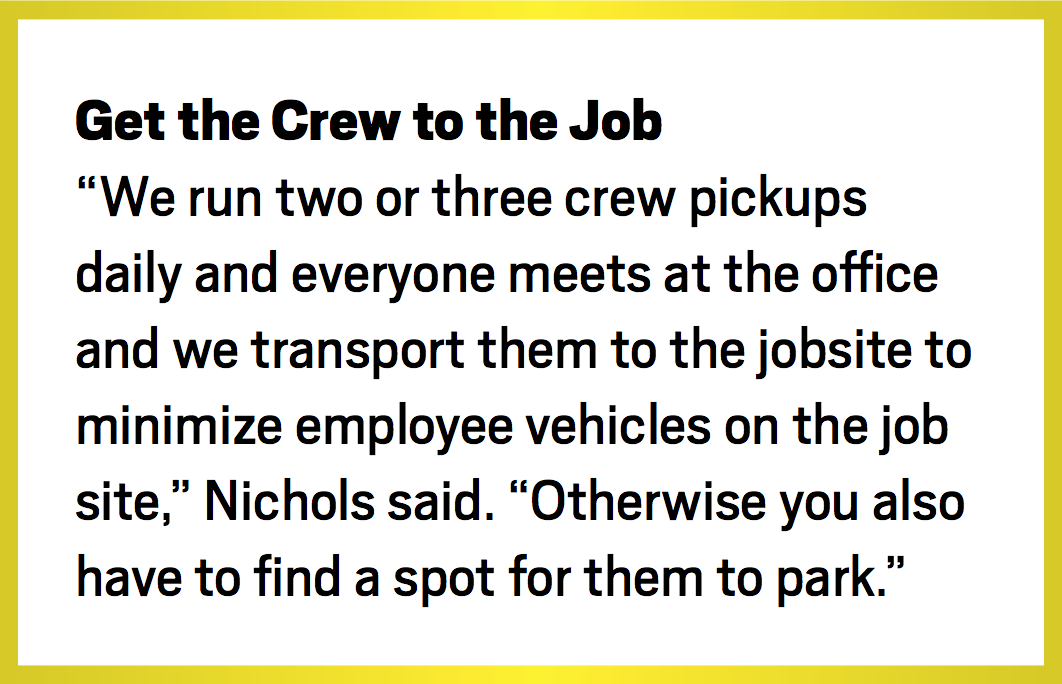How to Stage Paving Equipment for Multi-Day Commercial Projects
BY AsphaltPro Staff
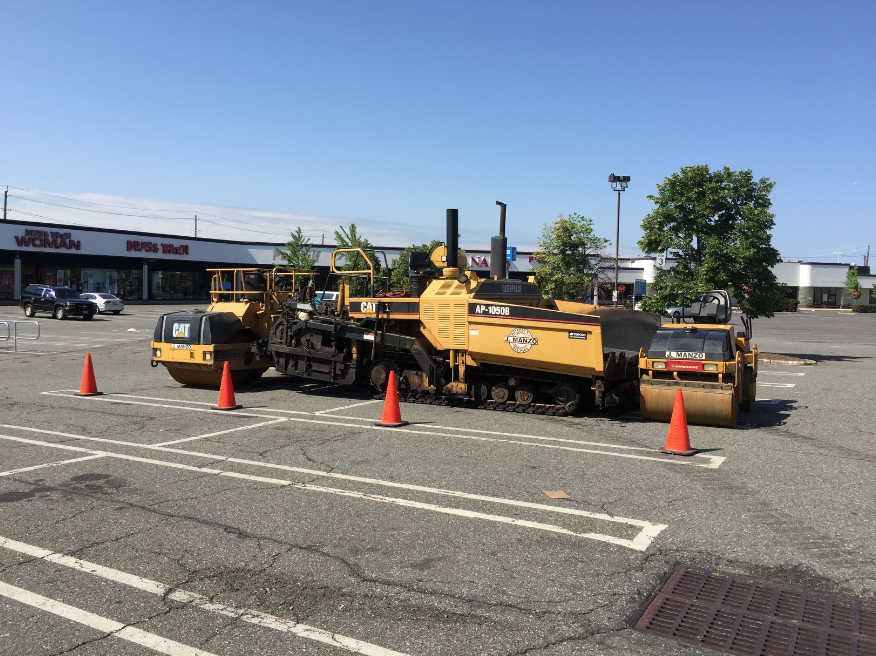
Here’s what you should have on hand and where it needs to be throughout the day for an organized and efficient job site.
You’re on a commercial lot for a project that’s going to take you three or four days to complete. You don’t want to have to send a laborer back to the shop to pick up buckets of release agent, a plate compactor or an extra diamond blade. You don’t want to get to the end of day one and realize you don’t have temporary paint to put down lines to open a parking area to traffic.
To tackle these sorts of jobs—especially if they’re new to you and your crew—organization is key. You need to know what to bring to the job site and who to bring to the job site. But that’s only half the battle. You also need to know where each piece of equipment needs to be at the start of each shift for an organized and efficient day at the job site. Here’s how three industry experts approach staging strategically.
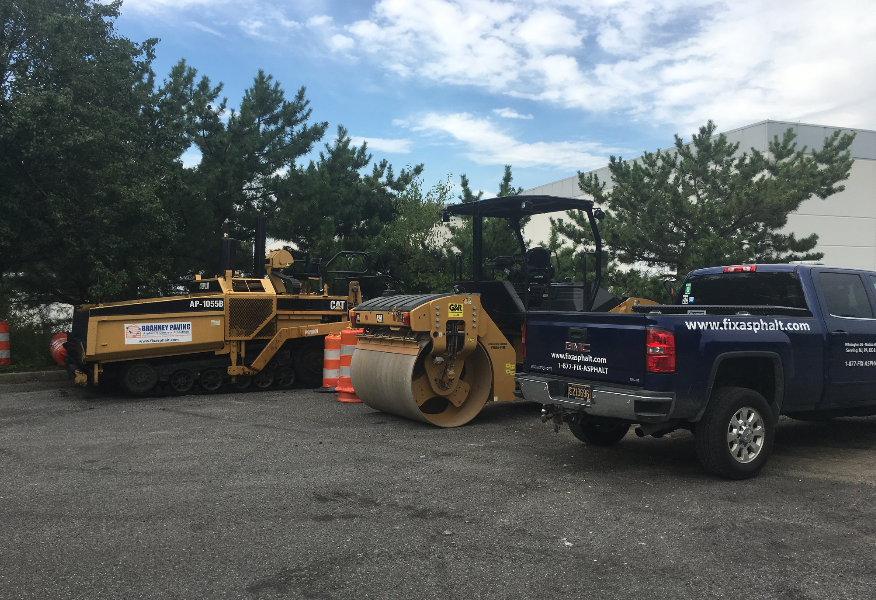
Ideally, you want to stage equipment in the order you plan to use it.
Prepare for the Job
Preparations for every job should start way ahead of the work day.
“What makes Mid-Ohio Paving work well is my salesman, Charlie Stewart, is good about preparing job folders for me,” said Chase Nichols of Mid-Ohio Paving, Centerberg, Ohio. In those job folders are all the notes he made during the estimate, as well as a copy of the estimate. “We also talk about every job a week or so ahead, what equipment is needed and where so I can stage it out ahead of me and my crew.”
Nichols said it’s key to coordinate between sales and operations to know what equipment to have on the job. That might mean a return visit to the property for the estimator shortly before the job begins.
“Say Charlie did an estimate this fall for a job in the spring,” Nichols said. “He’ll revisit the site to be able to give me current scenarios, just in case something has changed since the estimate, like weeds that have grown up, dumpsters that have been moved, or abandoned vehicles.”
For Steve Brahney of Brahney Paving and 1-877-FIX-ASPHALT, in Mullica Hill, New Jersey, and Wilmington, Delaware, preparations also begin with the estimate.
“Anything we need, equipment-wise, I usually pull out of my estimate,” he said. “At the very beginning of the job, I already know which pieces of equipment I’ll need, how many barricades I’ll need, everything.”
Then as the job draws closer, it’s much easier to get everything on that list to the job site.
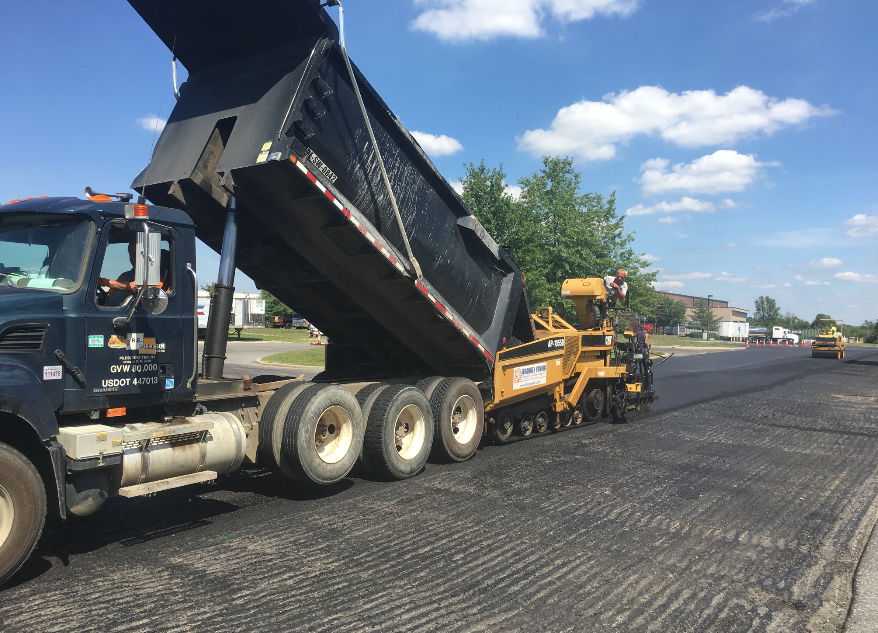
When staging for a multi-day commercial job, it’s important to plan where your equipment needs to be at all times so your crew has what they need to succeed without returning to the shop or driving over the newly laid mat.
Get Equipment to the Job
When it comes to multi-day projects, Brahney prefers to stage the day before.
“We want to avoid the possibility of our equipment getting caught in a traffic jam while our crew waits at the job site the morning we want to get started,” he said. If the plan is to mill in the morning and pave in the afternoon, he also makes sure the milling equipment will be the first to arrive.
To get everything to the job site, Brahney subcontracts with a company with a lowboy to move his equipment.
“We find lowboys are best to move everything because they can move more than one thing at a time,” he said.
Another benefit of using lowboys is Brahney can get most of the gear he needs to the job in just two or three trips rather than the six or seven trips it might take to haul everything with smaller trailers.
According to industry expert and retired paving superintendent Ray Eisner, equipment can be on the job the night before half the time, but the other half of the time, it may need to arrive the morning of. If that’s the case, it’s usually being serviced and loaded at 4 or 5 a.m. to make it to the job site before the crew does.
Nichols also prefers staging the day or night before.
“Typically the way we operate, our prep equipment usually sits there ahead of time waiting for us to get there,” he said. “Then we show up and prep the job site as our paving equipment is being mobilized.”
To get its equipment to the job, Mid-Ohio Paving uses two 53-foot lowboys, both pulled by W900 Kenworths: one Eager Beaver detachable trailer with a removable goose neck and a removeable third axle for 100,000-plus-pound moves, and one Nuttall trailer especially made for asphalt pavers.
“With the Nuttall one, you don’t have to worry about the hassle of detaching from the trailer,” he said. “And the ramps are at a slight slope so you don’t have to worry about the screed or augers dragging.” The removable goose neck trailer is designed for equipment that is a bit wider or bigger, because it is loaded from the front and its deck is quite a bit lower to the ground.
Typically, Nichols moves two skid steers with various attachments—depending on the job—on one lowboy and then moves its paving equipment, with the paver and a small vibratory roller, on the second lowboy. The company also has a water truck with a small equipment trailer to pull the finish roller.
“That’s a key point,” Nichols said. “The finish roller is able to be hauled alone. That way, the paver and breakdown roller can be loaded and transported without rushing the finish roller, since it’s usually working for another hour after we’re done.”
During the day, Eisner said, it’s important to either return your lowboys to the yard or keep them well out of the way of your crew. “In most cases, since our lowboy drivers may also haul mix, they can pull the empty trailer along with their last load of asphalt and that’s legal in most states,” he said. “That way, they can unhook the trailer at the job site, unload their mix, and then load up the equipment.”
Mid-Ohio’s smaller tools, like blowers, shovels and lutes, arrive with the crew. In addition to more common tools, Nichols’ crew always has a weedwacker to tackle any overgrown grass and a 12-foot extendable pole saw to remove tree branches that could get in the way of its dump truck beds.
“We make the owner aware of what branches we may cut during the estimating process,” Nichols said. “But we also have a conscience when we’re trimming trees. We don’t butcher them.”
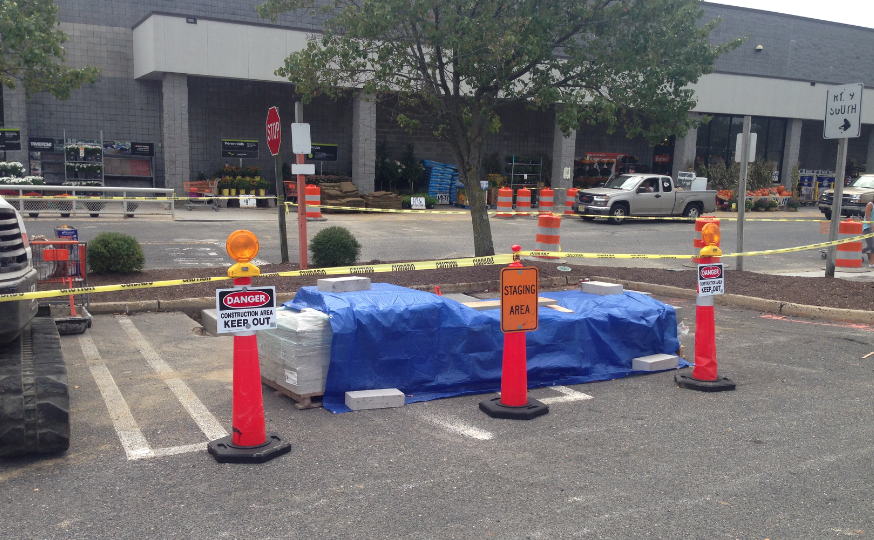
At minimum, Brahney said the equipment is surrounded by safety barrels with flashing lights and “No Trespassing” signs, like you see here.
Stage your Job Site
As the equipment arrives, Nichols’ crew knows the importance of staging their equipment so it won’t be in the way when they arrive and get started in the morning.
“It’s important to place things on the job to make morning procedures easiest,” Nichols said. “When you’re staging the night before, you always want to make sure you’re making it easy for the operator to check the engine fluids the next day.” For example, because his skid steers’ engine compartments are on the back and require a bit of space to open, he makes it a point not to park them too close together. His crew also makes sure the hopper is down to allow access to the engine panel needed to check the engine oil on the paver.
“If you don’t, the next morning, the operator will have to start it, move it, let the fluid settle and then check,” he said. “And nine times out of 10, if you don’t make it easy, that operator may not check it in the morning. You have to make it easy.”
You also must consider what order the equipment will be used in.
“Have you ever heard the term, ‘You don’t want to paint yourself into a corner’?” Chase said. “That works directly with paving.”
For example, he said, if you’re on a multi-day paving job, you don’t want to park your paver overnight where you need to shoot tack in the morning. “Then you have to move it before you shoot the tack.”
Typically, if he’s starting on one side of the job—let’s call it “Point A”—his prep gear is lined up in order of use in that corner. As the crew moves forward with its preparations, the paving equipment will be parked in order of use near Point A.
“Then it’s already clean and ready for asphalt the next morning,” he said. “And I’ll usually pave in the same pattern—from Point A to Point Z.”
For Brahney, the paving equipment is often off the jobsite entirely, on a side street or a neighboring property if possible, while the site is prepped, and vice versa.
“The only equipment we want on the job is what we’re using for the task at hand,” he said. “We don’t want to keep moving things throughout the day.”
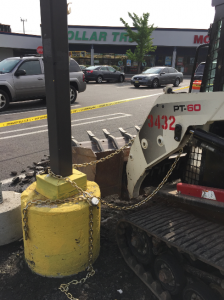
According to Brahney, skid steers are among the most commonly stolen equipment because of their skeleton keys matching other machinery. To prevent this, he locks equipment together or to immovable objects.
Keep Equipment Safe Overnight
Even more important than staging equipment strategically is staging equipment safely. Both Brahney and Nichols stress the importance of parking equipment in a well-lit area that’s out of the way.
“Even if it may not be entirely out of the way, we’d prefer to park our equipment in a well-lit area—preferably with security cameras nearby—to prevent theft and vandalism,” Brahney said.
He’s also sure to notify any security personnel that once the crew leaves, no one should be near the equipment unless they arrive in a company vehicle.
According to Brahney, skid steers are among the most commonly stolen equipment because of their skeleton keys matching other machinery.
“To prevent that, we lock a lot of our equipment together and try to park the smaller equipment in the middle, put it against a curb, or lock it against a building,” he said. “We sort of try to create a moat around them.”
Nichols also makes it difficult for would-be thieves to get to anything removable: batteries, electronic devices and hand tools.
Since Brahney’s crew typically has to stage for safety the night before, the next morning typically starts with staging equipment for the actual prep and paving process.
“We always try to keep the equipment together for safety reasons,” he said. “It can be a pain in the butt because you may have to move things again in the morning, but it’d be much worse to get to the job site and be missing something.”
At minimum, Brahney said the equipment is surrounded by safety barrels with flashing lights and “No Trespassing” signs.
“We’ve also started to post limited liability signs,” he said, to prevent people from climbing on equipment, getting injured, and potentially suing his company. He’s also sure to take photos of the signs with GPS and time tags, just in case an issue does arise. “Our insurance company loves us for it.”
Start the Day
According to Brahney, every day should start with a crew huddle.
“For example, if we’re working on a shopping center and we want to pave before they open at 10 a.m., we need to start milling at 3 a.m. and the guys will know we need to start paving by 6 a.m.,” he said. “Once everyone knows the game plan, we don’t have to give much direction.”
But there are some special considerations the foreman on the job might still need to tackle. For example, since the first day of a multi-day job is typically a prep day, that’s when Nichols scopes out the job site for an area to heat the tack truck and clean out the haul trucks and paver.
“If I’m working in a city, I might look for an adjacent lot with a lot of potholes and offer to patch them or some type of accessible area where mix could be placed in a respectable manner,” Nichols said.
If there’s nowhere to clean out the paver, he’ll plan to run the material out onto the ground and reload it onto the last dump truck. If there isn’t an area where the residue from washing out the paver can easily be cleaned up, he’ll pull it onto the lowboy and very lightly spray it with release agent and will thoroughly clean it and the trailer deck later.
Another thing to consider is the tack truck. If you’ll need to shoot tack, you’ll need to make sure to give it enough time to heat up.
“If I don’t have to worry about customers or employees, I’ll apply the tack the night before to give it plenty of time to break and prevent tracking,” Nichols said. However, he estimates that 70 percent of his jobs require the crew to apply tack the same day it’s paving.
“You need to think about where the tack truck should heat up,” Nichols said. The first thing he looks for is a safe area, and, if he has the option, he prefers that the tack truck heat near Point A. “Probably somewhere like Point D,” Nichols said.
He also makes sure there is always someone trained to operate the distributor within 25 feet of the truck while it’s heating.
“During that time, this employee can be doing anything he can to be productive within that area, like cleaning the distributor truck and keeping materials from building up and creating a safety issue,” Nichols said. On a recent chip and seal job, a hired transport made a point to tell him Mid-Ohio’s tack truck was the cleanest he had ever seen. “A clean tack truck is a happy tack truck.”
While You Work
During the work day, it’s important to anticipate and plan for your crew’s needs. For example, Nichols always has the water truck following the finish roller so the operator never needs to travel far for water.
“Having the water source close also means the drums are less likely to get dirty and track contaminants onto the mat,” Eisner said.
The crew trucks are usually running ahead of the paving train, which also allows them to act as traffic support as the crew ends the job by paving the lot to meet the street. When it comes to access to hand tools, Nichols said some crew members needing hand tools always have the tool in hand. For example, his lute guy, Phill Bowers, is never without his lute throughout the day. For other tools, like shovels, he expects the crew to put them back on the screed of the paver whenever they don’t need them throughout the day.
Another consideration Nichols must make is how to handle his haul trucks.
“I like to have one truck in the box and an additional truck on site so there’s no waiting,” he said. To ensure that can happen, staging strategically is key. Typically, Nichols has the next haul truck 100 to 200 feet ahead of the paver, depending on when he expects to need that asphalt. “On anything larger than 100 tons or so, I like to let two or three trucks stack up before we crack the first one,” he said. “This helps set the spacing with haul trucks.”
“Just the other day we were paving a 60-foot by 750-foot lot, so we paved six 10-foot-wide passes,” Nichols said. “After that first pass, we had an idea of how many loads it takes to complete each pass and we adjusted from there.”
Ninety percent of the haul trucks on Nichols’ jobs are Mid-Ohio trucks, and all of his drivers know they need to scrape the tailgate with a putty knife after every load—not where the lot meets the road, but towards the end of the job—at corner X or Y.
“When the truck leaves the paver, it’ll go to that predetermined spot and raise the bed all the way up and scrape that tailgate off,” Nichols said. “A lot of times, haul truck drivers will want to clean out 30 or 40 feet ahead of the paving train and you’re constantly having to clean a mess right ahead of the paver. We don’t do that. We think ahead. We leave no mess.”
To ensure every driver knows the procedure, the crew member who is responsible for getting each driver’s load ticket reminds every truck where to clean out during the first load of the day. Towards the end of the day but before needing to pave that area, all that material makes its way into the last dump truck of the day.
Depending on the layout of the lot, Brahney said, it may also be important to consistently have a skid steer with asphalt nearby for when you’re paving around obstructions. “That kind of job isn’t like paving a long distance where you might not need a skid steer until the end of the job,” he said.
Another important thing to keep in mind is making sure you aren’t leaving any equipment back where the crew began paving, because you won’t be able to drive on top of the new asphalt, Brahney adds.
End the Day
At the end of every shift, there are a number of maintenance and safety items to check off your list. But what about preparations for the next day?
Both of Mid-Ohio’s crew trucks are equipped with auxiliary fuel tanks, and Nichols is very strict to make sure the crew refuels at the end of the shift to prevent condensation from forming inside the fuel tank and reducing his equipment’s efficiency.
“I think it’s also faster to fuel at the end of the shift because it will get done quickly, since everyone is trying to get done and get home,” Brahney said. “If it’s done in the morning, it tends to drag out.”
“It’s best to fuel at night, so in the morning the crew can get off to a good start and there’s no messing around,” Eisner said. He also stresses the importance of cleaning and greasing the paver at the end of every shift and tidying up the job site.
“The guys also need to clean their tools off and look around the job site, sweep up after themselves, pick up trash, and make sure all tools are back on the foreman’s truck,” he said. Not only does stowing the tools every night deter thieves, it’s also a matter of safety. “If you leave a shovel out and someone steps on it and gets hurt, you’re opening yourself up to lawsuits. Cleanliness is Godliness.”
In summer, Eisner said it’s best to fill the rollers up the night before. “But this time of year, you have to drain them every night,” he added. When the weather gets below freezing at night, the crew should run a solution through the spray system so the nozzles aren’t frozen in the morning.
Unless it’s the last day on the job and you’re packing up, Brahney said it’s important to remember the safety of your equipment overnight.
“It’s important to re-secure all equipment, lock everything, make sure all safety checklists are followed, barricade or caution-tape the area, etc.,” he said.

